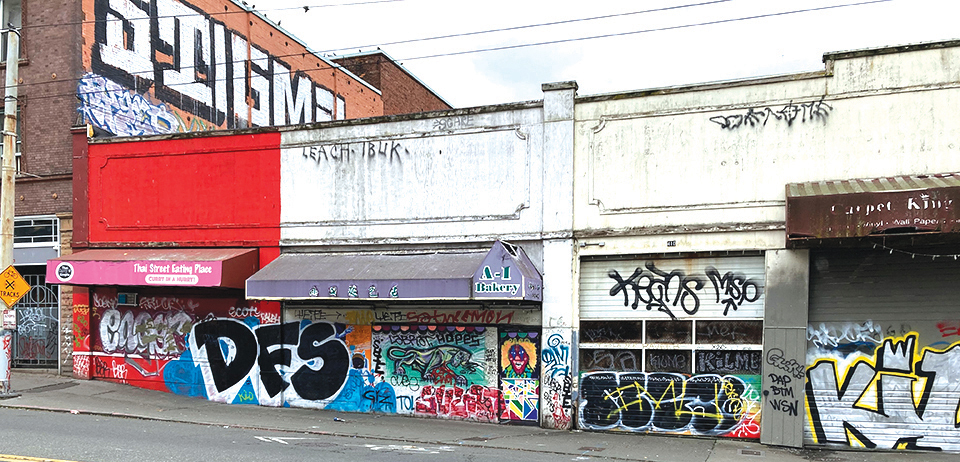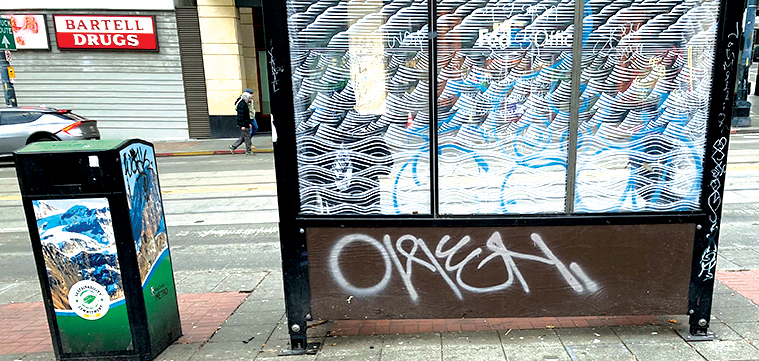By Mahlon Meyer
Northwest Asian Weekly
On the sidewalk in the Chinatown-International District (CID) one day last week, a man in tattered clothes lay on his belly, moving his red finger mindlessly over the damp concrete, back and forth.
His hand was jerking, like the twitching tentacle of an insect that has been smashed. It looked like he was writing something.
However ludicrous it may sound, according to reporting guidelines by Seattle Public Utilities (SPU), anyone could have reported him for writing “graffiti” on the sidewalk—so long as they believed they had seen it.
It only takes a report, which could be submitted to SPU for any reason—complaint, concern, or whim—for SPU to go into action.
“Notices are sent out when a report comes to SPU via the Find It Fix It app, online, or graffiti reporting line,” said Sabrina Register, a spokesperson for SPU, in an email. “We encourage all customers to report graffiti so it can be abated.”
A violation
On the same day last week, the storefront of a bakery in the CID was saturated in graffiti. The owner said he had tried to fight against the tide by painting and repainting. But each time, a new surge of graffiti would emerge the next day like someone spitting on his front wall—except the person had done it in paint.
(The owner asked for anonymity, because unlike others, the city had not yet given him a notice and he did not want to call attention to his business.)
“It’s not our fault.”
He cited the loss of business in the CID and the lack of public safety. Since the pandemic, and the loss of office workers, who now work from home or are too afraid to come to the crime-infested neighborhood, business has dropped 90-95%, by his count.
“And that’s not just for me, that’s for everyone,” he said. “Where there used to be 100 people coming to the CID for lunch, there are now 5 or 10.”
Instead, gangs or violent criminals roam the street at night, with impunity, he said. The police don’t stop them—they graffiti everything.
SPU: handing out notices equally
SPU says that the CID is no different than other parts of the city. Every place has graffiti. In fact, a spokesperson said, the CID got only 2% of second notices sent to businesses threatening fines up to $5,000.
But the context is different. The CID has 18 homeless shelters within a radius of one mile, bringing criminal elements into the area. Most other neighborhoods in the city and in King County have none, or at most, one (kcrha.org/regional-services-database).
The CID has been the victim of Asian hate, as well, which adds to the graffiti and vandalism.
And yet one day last month, a business owner shared with the Northwest Asian Weekly a notice of a $100 daily fine for graffiti on his building.
“Dear Property Owner,” it began, and threatened a court date unless graffiti was removed “at your expense.”
Asked why a particular business was singled out—this business owner also insisted on anonymity for fear of greater legal troubles with the city—SPU confirmed it was purely up to whomever reported it.
In fact, SPU elaborated, the city has an app that allows anyone to report a graffiti violation.
“When a report of graffiti is made through the City’s Find It Fix It app, online, or graffiti reporting line, SPU sends a letter that informs the property owner of the graffiti report, their responsibility under the Graffiti Nuisance Ordinance, resources like paint and supplies to help them remove graffiti on their property, and tips for making property more graffiti resistant,” said Register.
The notice shared with the Northwest Asian Weekly, however, did not offer any resources or help for removing graffiti, nor did it offer any tips for preventing graffiti.
It merely ordered the graffiti removed, threatened a fine of $100 a day up to $5,000 maximum, and told the business owner to call a number “when you have removed the graffiti or if you have questions regarding this letter.”
(SPU said it offered assistance in a first notification letter and that it included a brochure with both notices).
CID: the fewest reports
SPU said it “is committed to ensuring equitable services to its customers across Seattle” and that it sends “notification letters to property owners in all parts of the city once graffiti is reported.”
Furthermore, SPU provided data, from its reporting app, that showed the CID had the least number of reported graffiti defacements, compared with some other neighborhoods. Pioneer Square, which is roughly twice the size of Chinatown had 456 incidents in 2019, 193 in 2020, 450 in 2021, and so far, in 2022, 531 reported incidents (SPU calculated that Chinatown is 51.7 acres, Pioneer Square is roughly 100 acres).
By contrast, in the CID, 165 reports were made of graffiti in 2020, 205 in 2021, and 189 so far in 2022.
But a simple walk around these neighborhoods reveals that, even to the untrained observer, the CID is awash in graffiti, while other neighborhoods have relatively less.
Then why the lower reporting for the CID?
One possibility is that although the CID is awash in graffiti—nearly every building has some form of graffiti on it—it may merely mean that for cultural, linguistic, or historical reasons (for instance, distrust of the government, based on centuries of neglect and harm) that less people report it. Or simply: because it is so commonplace.
The mayor’s citywide plan fails to pass
Seattle Mayor Bruce Harrell introduced a package for graffiti cleanup that allotted $944,000 in funding and set out kits and teams of volunteers to address the problem. It also included funding for additional SPU graffiti rangers who would have been specifically tasked with helping businesses remove graffiti on their property.
The “One Seattle Graffiti Plan,” as it was called, was a city-wide approach. In pushing for his agenda, Harrell showed that since 2019, graffiti incidents reported by the public have grown over 50%. There were nearly 20,000 reports of graffiti and tagging in 2021 alone.
But the measure didn’t pass the city council.
The council budget chair chose not to include these investments in the balancing package and members of the council did not add them back in during the amendment process.
Jamie Housen, director of communications for the mayor’s office, said that graffiti abatement remained a top priority as part of the mayor’s strong support for small businesses.
“As part of our Unified Care Team pilot project, we are coordinating graffiti work in the CID. Since early October, the SPU Graffiti Rangers Program has abated 9,103 square feet and 130 public assets in the CID,” he said. “We are committed to continuing these efforts, so the CID is a clean and welcoming neighborhood for residents and visitors.”
CIDBIA’s role?
In an email, Register said, “SPU provides funding to the Chinatown-International District Business Improvement Area (CIDBIA) (and eight other BIAs across the City) to help keep the neighborhood clean. These funds can be used to abate graffiti and pick up litter in alleys, along streets and in other public spaces.”
SPU has provided funding to CIDBIA for more than 20 years, she said.
This year, SPU gave the organization $26,000 for cleaning.
Monisha Singh, CIDBIA’s executive director, did not respond to emailed questions.
Resuming notices
In the end, though, there appears to be no clear rubric about how the city judges what constitutes fineable graffiti, say business owners—besides simply the judgment of any individual who chooses to file a report.
Notices were paused during the pandemic, according to SPU. Harrell ended the city’s civil emergency proclamation on Oct. 31. The date of the notice shared with the Northwest Asian Weekly was a few weeks later.
All bark and no bite?
The ordinance around graffiti was created in 1996 and does say the city can fine people for not cleaning up graffiti on their property. But SPU says it rarely actually does—but it can.
The Graffiti Nuisance Ordinance “requires property owners to remove graffiti on their property to protect public health, safety, and welfare. The ordinance states that property owners must remove the graffiti after the city requests that they do so,” said SPU, which is responsible for enforcing the ordinance.
And yet, SPU said, “While property owners who don’t remove graffiti can be subject to fines, this rarely happens.”
Register said no property owner has been fined since 2014.
“We know property owners are victims of a crime,” she said. She said, again, that SPU offers paint and supplies to help.
In the eye of the beholder?
But it’s not clear if the reporting mechanism is being used in an equitable way, say business owners.
Property belonging to the city, the county, and Sound Transit, if defaced by graffiti, must be “abated”—cleaned up—by those agencies themselves.
On a recent walking tour of the neighborhood, however, this reporter found that none of those agencies had “abated” the graffiti on its properties.
Parking meters, bus stops, even the headquarters of Sound Transit were slathered with graffiti.
Mahlon can be reached at info@nwasianweekly.com.





